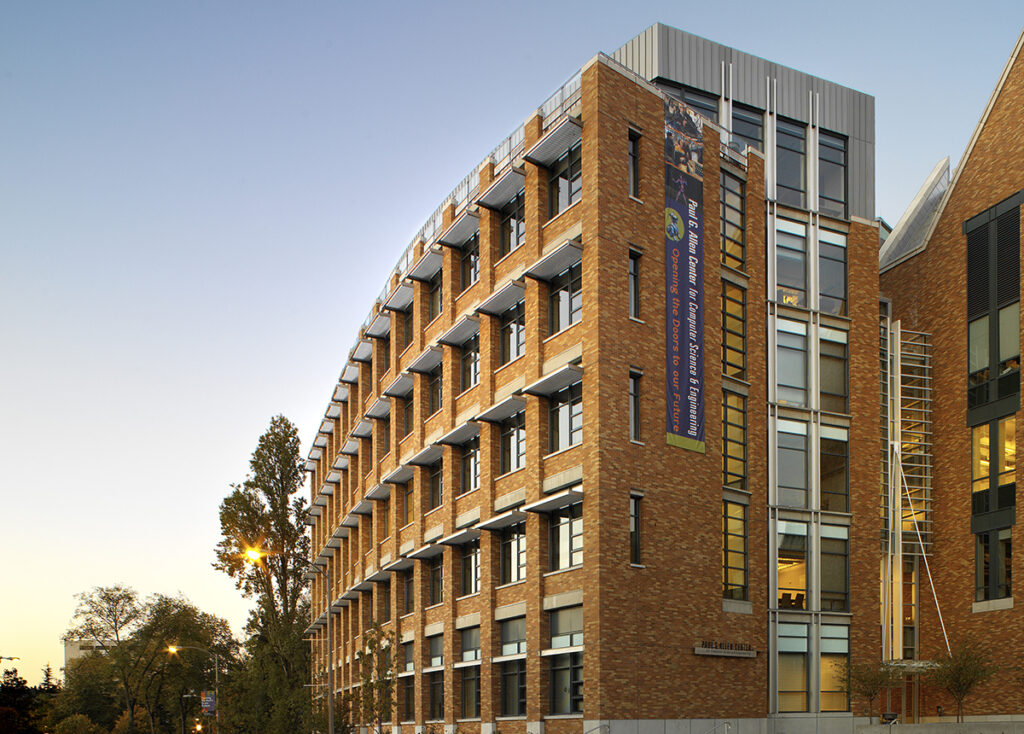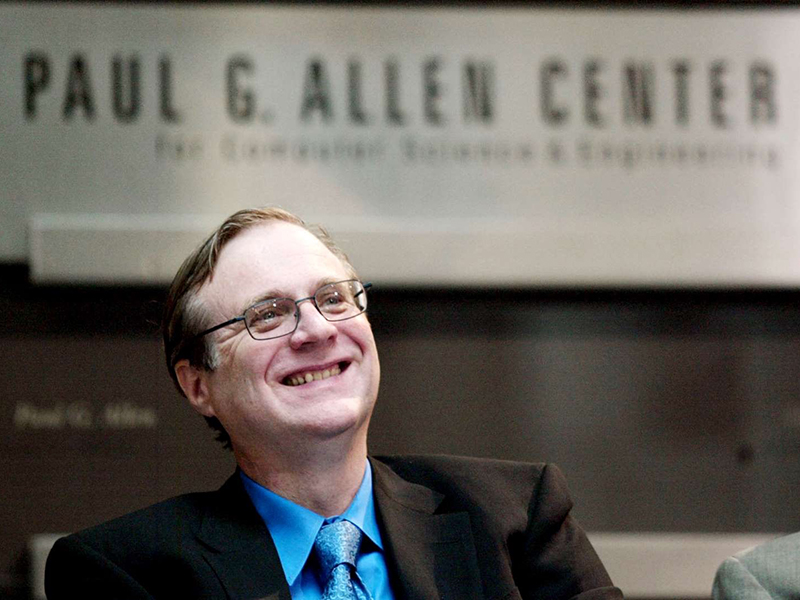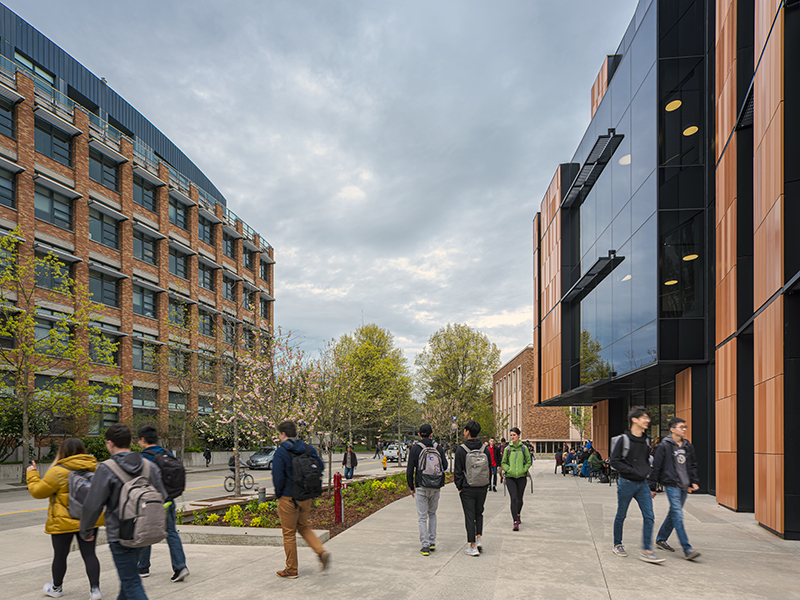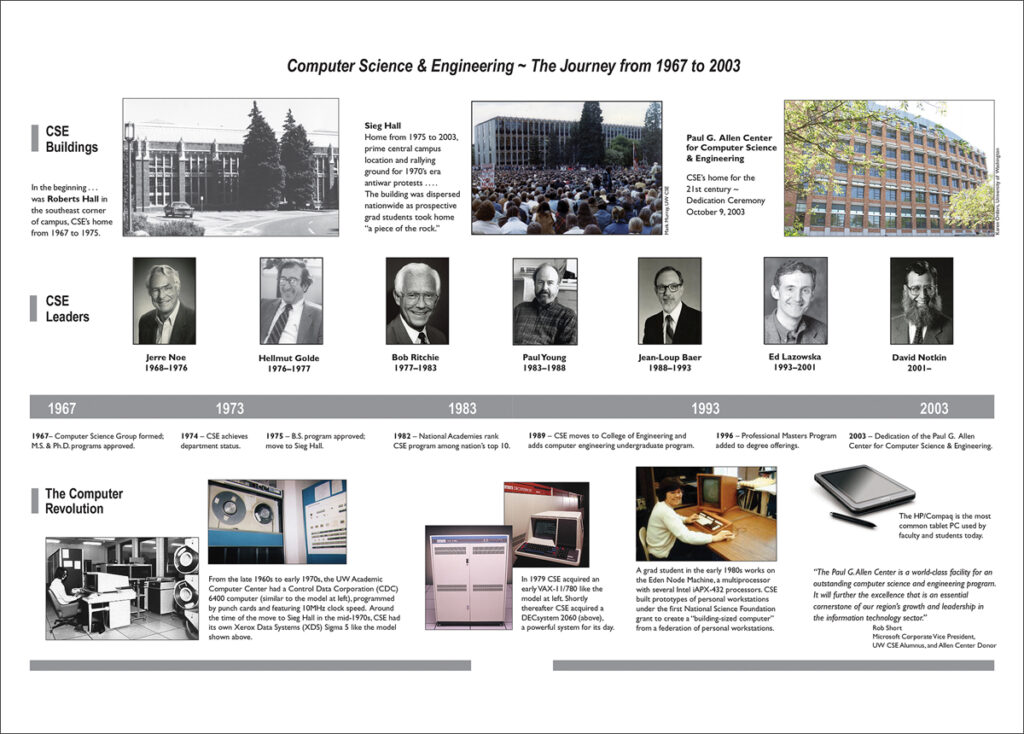
In the late 1990’s, members of the Allen School faculty experimented with a new — some would say unorthodox — way to mark the conclusion of Visit Days, the annual pilgrimage made by prospective graduate students to computer science programs around the country. To commemorate the visitors’ time in Seattle, professors in what was then the Department of Computer Science & Engineering would cheerfully send them on their way with a surprise parting gift: a palm-sized chunk of concrete.
The concrete in question had, without any human intervention, become dislodged from the crumbling facade of Sieg Hall — the building that, should the recipients choose the University of Washington, would become a home away from home for the duration of their Ph.D.
“The souvenir definitely made us memorable, and it helped our cause when it came to recruitment,” Allen School professor Ed Lazowska, who chaired the department at the time, recalled wryly. “One student emailed that they just couldn’t say ‘no’ to us after we literally gave them a piece of our building. But giving out chunks of the building, like the building itself, was a joke. We were woefully behind other top computing programs when it came to facilities.”
While outside the building was crumbling, inside it was cramped — so much so that, as a prank, someone set up a “graduate student office” on a ledge in the stairwell, complete with a handy rope ladder for access. More than two decades after it first housed UW’s burgeoning Computer Science & Engineering program, Sieg was no longer fit for the purpose. In 1999, the department stepped up its campaign for a new, permanent home.
Lazowska and local technology industry leaders led the charge, forging a public-private partnership that was unprecedented in UW’s history. All told, they raised $42 million in private funds — substantially more than half the project’s cost — from more than 250 donors. Lazowska’s faculty colleague Hank Levy oversaw the design and construction of the building in tandem with LMN Architects and general contractor M.A. Mortenson. He saw to it that the funds were put to good use.
“Our goal was to create a warm and welcoming environment that would facilitate teaching, research and collaboration,” said Levy. “Every aspect of the building — the materials, the artwork, the abundant natural light, the open spaces that encourage people to gather and exchange ideas — were intentional choices made with this goal in mind.”
Those choices were supported in large part by leadership gifts from the building’s namesake, the late Paul G. Allen, along with the Bill & Melinda Gates Foundation and Microsoft. Completion of the 85,000 square-foot facility, which was dedicated on October 9, 2003, tripled the program’s available space and set off a chain of events that made the Allen School into the powerhouse it is today.

Allen himself understood at the time that he was investing in something more meaningful than bricks and mortar.
“I’m proud to have supported this beautiful and unique facility, but what really sets UW’s computer science program apart are the people,” Allen observed during the grand opening celebration. “The faculty here is unparalleled, and the undergrad and graduate students are dedicated and inspiring.”
Allen’s faith would inspire a period of expansion that no one — including Lazowska, who has been the program’s most vocal cheerleader over the years — could have foreseen in 2003.
“I cannot stress enough the importance of the Allen Center to the trajectory of our program,” he said. “It provided us with competitive space for the first time in our history. It was the spark that set us on a path to triple our degree production, ramp up our ability to deliver computer science education to students across campus, and attract the brightest researchers in the field to Seattle.
“And in the midst of all that,” Lazowska added, “we became a full-fledged school!”
On move-in day in the summer of 2003, fewer than 40 faculty members unpacked boxes in their shiny new offices; two decades later, that number is approaching 100. And faculty recruiting has barely kept pace with the explosive growth in student interest, with the Allen School the most requested major among freshman applicants to the University for several years running. It now serves roughly 2,800 students across its degree programs — and thousands more who take one or more courses as non-majors each year.
As the program grew in size, it also grew in stature, thanks in no small part to its new and improved laboratory space.
“Computer Science & Engineering at the University of Washington is an engine of opportunity,” Allen had said at the time, “and I want to ensure it’s an even more cutting-edge resource for the coming generation.”
That engine has been going full throttle ever since. One high-profile example of how the move to the Allen Center greased the wheels of innovation is UW’s emergence as a center for mobile health. By tapping into the built-in sensing capabilities of smartphones coupled with advances in machine learning, Allen School researchers, in conjunction with UW Medicine clinicians, have developed a range of mobile tools for screening and monitoring of a variety of health conditions spanning fever, pre-diabetes, sleep apnea, infant jaundice, reduced lung function, ear infection, newborn hearing loss and more. All got their start in the Allen Center’s labs, and several led to the creation of Allen School spinout companies.
The collaborations don’t stop there, as the Allen Center provided a launch pad for multiple cross-campus initiatives, some supported by significant federal and/or private investment. These include efforts to advance accessible technologies and more accessible communities, data science for discovery and innovation, neurotechnologies for people with spinal cord injury, stroke or other neurological disorders, next-generation cloud computing infrastructure, computing for environmental sustainability and more. In the past five years alone, the Allen School has secured more than $200 million in grants and contracts to support its research. Along the way, the school has strengthened its leadership in core areas such as systems, architecture and theoretical computer science even as it has expanded its expertise to encompass new areas, including cryptography, molecular programming, quantum computing and natural language processing.

And that list is by no means exhaustive.
“We took Paul’s words to heart, and the impact of the community’s investment continues to be felt today far beyond the Allen Center’s walls,” said Magdalena Balazinska, director of the Allen School and Bill & Melinda Gates Chair in Computer Science & Engineering. “It is felt through the graduates we’ve mentored, the technologies we’ve developed, the companies we’ve started, the opportunities we’ve created, and the leadership we’ve provided.”
The growth sparked by the Allen Center eventually led UW to break new ground in computing literally as well as figuratively; nearly 16 years later, with its first building now bursting at the seams, the Allen School dedicated its second building, the Bill & Melinda Gates Center, which doubled its physical space.
That additional space came just in time, too. Thanks to advocacy by the University and additional investments from the state legislature, the school is currently on track to award 820 degrees annually and has cemented its place in the top echelon of computer science programs in the nation.
“I said back then that the true measure of this building will be what we do inside to take our programs to the next level of excellence,” said Levy. “I’d like to think that we lived up to that promise, and then some.”
For more on the Allen Center’s history, see the Allen Center dedication brochure, a special pre-dedication insert in the Most Significant Bits newsletter, and the dedication issue of MSB from fall 2003.


